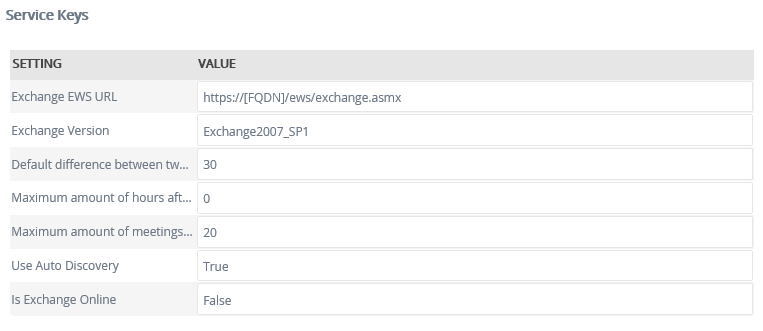Exchange Management
The Exchange Management Service Type allows the management of Calendar, Task and Meeting items. This broker exposes Exchange methods to create new meetings, new appointments and new tasks. It also includes functionality to get meeting time suggestions and to get conflicts. The Exchange Management Service is used internally by K2 for some of the Exchange workflow wizards.
An instance this Service Broker is configured during the K2 installation process if Exchange integration information is entered in the relevant installer screens. You can also create additional instances manually.
Service Authentication
The following Authentication Modes may be used with the Service Type:
- Impersonate
- ServiceAccount
- Single Single-on
- Static
Service Keys (Service Instance Configuration Settings)

| Key | Can be modified | Data Type | Sample Value | Notes |
|---|---|---|---|---|
| Exchange EWS URL | Yes | Text | https://[FQDN]/ews/echange.asmx | Enter the URL of the Exchange Servers Web Service |
| Exchange Version | Yes | Text |
Exchange2010 Exchange2013 |
Enter the version of the Exchange Server |
| Default difference between two successive slots in the free/busy information field | Yes | Number | 30 | Enter the default amount required |
| Maximum amount of hours after work to consider | Yes | Number | 0 | Enter the maximum number of hours required |
| Maximum amount of meetings per day | Yes | Number | 10 | Enter the maximum number of meetings allowed |
| Use Auto Discovery | Yes | True/False | True | |
| Is Exchange Online | Yes | True/False | False | Set this value to True if you are targeting an Exchange Online environment. |
Service Objects
The Exchange Management Service Instance contains the following Service Objects:
- Exchange Calendar
- Exchange Task
- Exchange Meeting
These Service Objects are used by internal SmartObjects, used in turn by the Exchange event wizards in a K2 process

SmartObjects
If an Exchange environment is configured during installation of K2, K2 automatically generates SmartObjects for the Service Objects. These SmartObjects are used by the Exchange Event Wizards. SmartObjects are automatically created when selecting the Generate SmartObjects for this Service Instance check box when creating a new Service Instance. Designers may use the available Service Objects in this service to create advanced SmartObjects using the available K2 SmartObject design tools. It is recommended to use the K2 Design tools to create SmartObjects rather than generating SmartObjects, since this allows better control over the naming, behavior and design of the SmartObject and its methods and properties.
Considerations
- The default Service Instance of this service is used internally by the K2 environment. Do not modify or delete the existing service instance. You can create a new instance or use the methods from the existing instance